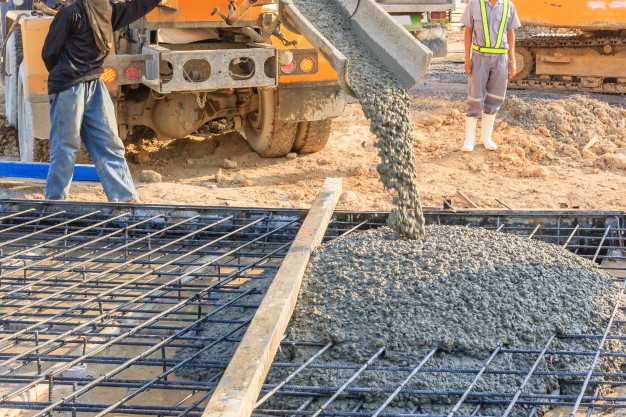Concrete mixture Cement:
It is a substance that is manufactured in factories, the basis of which is lime and clay materials that are crushed together and mixed, and then exposed in the kilns of cement factories to a high temperature for a specific period, thus producing a substance called (clinker) that is then ground (clinker) to a very high degree of fineness, and gypsum and some other materials are added to it. To give it special specifications, it is packed in bags, the form in which cement is put on the market.
In the concrete industry: when cement is mixed with water, a cartilage substance is formed that gradually takes its strength and hardens, as this carnivorous substance encapsulates small and large aggregates and binds them to each other, forming concrete.
The cement takes its initial strength (initial setting) after about 45 minutes of being placed in the mincing (molds) and reaches the final set after about 10 hours. The cement went most of its strength after 28 days, knowing that its strength increases with time at a slow rate if the surrounding conditions in terms of temperature and humidity are appropriate.
Take into account when storing cement on the site:
- The storage period shall not exceed 6 months from the date of production.
- To be stored away from moisture (moisture of the ground or air).
Concrete mixture Cement types:
There are many types of cement, the most common are the following:
1- Ordinary Portland cement:
It is the type commonly used in concrete and all architectural works, and this type gains most of its strength after 28 days of casting.
2- Early Portland cement with high resistance:
This type has almost the same initial and final setting time as ordinary Portland cement, but it acquires its high strength after about 3 days (which ordinary cement needs 28 days to reach). This type is used in paving works, airstrips, and works that need to be completed quickly.
3- Low-temperature Portland cement:
This type is characterized by low temperature resulting from the reaction of cement and water (hydration process). We use this type when it is necessary to pour large concrete blocks, as in dams, etc. (as the high heat that results from the interaction of cement with water in the case of pouring large concrete blocks causes cracks in the concrete).
4- White Portland cement:
It is the standard type used in finishing works, as it is distinguished by its white color. It is used in the work of tiles, ceramics, stairs, and visible concrete, and colored materials can be added to it to give it the desired color.
5- Sulfate-resistant Portland cement:
This type is characterized by its high ability to resist the damaging effect of salts and sulfates on concrete. It is used in concrete works exposed to water containing high levels of salts and sulfates, especially in foundations and marine works.
Source: wikipedia.org/wiki/Reinforced_concrete
Read More: buildineg.com/public/blog/what-is-a-concrete-jacketing-of-column/

